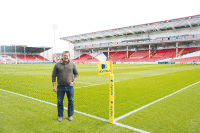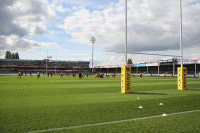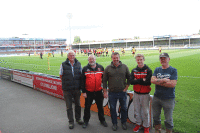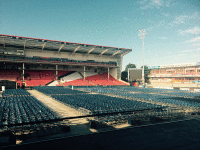Kingsholm - Upping their game

The Bayer Turf solutions team talked to members of the groundstaff at Kingsholm about preparing the pitches and maintaining the high standard of play required throughout the tournament
Of the thirteen venues for the Rugby World Cup, Kingsholm in Gloucester was the only soil pitch and, according to Graeme Balmer, the pitch consultant, this means the ground is softer and more prone to wear than reinforced pitches.
"Maintenance levels are high, especially when it comes to divots coming out from scrummages. We have a large team of eight people divoting at half time and after the game," says Graeme.
"Over the past few months, we've had a lot more rainfall, and this could have made it softer but, thankfully, we have good drainage here. It was tested and it was in spec," he says.

"Even though the fixtures were set, there was still a contingency for anything that might affect turf quality, such as bad weather, which meant that the games could be delayed or even rescheduled."
"So, while we were still implementing long-standing practices for the World Cup, I'm not going to deny that we didn't up our game, because we were in the spotlight, in front of the world."
"Because it had been a wet summer, for instance, we had to apply more fertiliser because it got washed away. We fertilised on a programme of six to eight weeks and upped the iron levels to ensure the turf looked healthy."
"We used a Wiedenmann Terra Spike for deep spiking and aeration and left the holes open, aiming to do this every two weeks during the season."

Selection process
Kingsholm submitted an application to be considered as a World Cup host four years ago. "We knew the pitch was big enough, the stadium had enough capacity and that we could cater for the hospitality required. It has enough boxes, has television access and we have international sized changing rooms."
"The closer we got to the tournament, they sent over more criteria which meant we had to make a number of changes to the stadium and pitch. During 2015, a representative working on behalf of the World Cup came to test that the pitch and turf met their criteria," adds Graeme.
Structural changes
The turf team at Kingsholm had to make some big changes to the pitch to ensure that it was fit to showcase to the world's leading rugby players… and a television audience of millions from around the globe.

"We had new international goalposts installed to replace the old posts made in 1964 by a local engineering firm Field and Platt. It was sad because that was a piece of history. But the great thing is that these were re-erected in the fanzone area, in Gloucester Quays, next to the big screen."
"The new posts are impressive, because they can be folded down to enable us to clean and paint them easily, and will help when we put the dome in during the colder winter months to protect against frost."
As well as changing the posts, they had to install fifty new lights into the stadium. This brought the total up to 150, all to help television presentation.
"We've also had to reduce the size of the pitch from 97 x 70 metres, with a seven and a half metre in-goal, to 95 x 68 metres and in-goals that are six metres deep."

As well as making structural changes, the turf team had to invest in new maintenance kit to ensure the turf met strict criteria set by the World Cup. Dave purchased a new Toro triple mower with boxes, because of the need to up the scale and precision of the mowing, to meet strict grass height stipulations.
"During the tournament, there was pressure to make sure the pitch met criteria throughout, and to keep it looking and playing impeccably. And this was a challenge, especially with three games in one week during September:
- Saturday 19th September Tonga v Georgia
- Wednesday 23rd September Scotland v Japan
- Friday 25th September Argentina v Georgia
In addition, Kingsholm hosted USA v Japan on Sunday 11th October.
"It was challenging to maintain the pitch when there were games in such close proximity, because it's not just the day of the game that you can't do any maintenance work, it was also the day before. Both teams had to train for two hours, in what they call a 'captain's run', one in the morning and one in the afternoon. Therefore, we lost a recovery window."
"We prepared the pitch for the captain's runs to the same standard that we prepared for the games, so we were working around these sessions and games, as and when we could," says Dave.

Kingsholm, like many stadiums, hosts a number of concerts and, this year, Madness played on 30th May and Elton John performed on Sunday 7th June. For the concerts, the turf team killed all the grass with a total herbicide, and the ground was covered, so the gigs could be performed.
Following this, on the 8th June the renovation started, they drilled the perennial ryegrass seed and, within two weeks, the grass was perfectly well established, and needed to be mown.
"We had to plan exceptionally well in order to make sure we successfully renovated the pitch for the World Cup. We started right after the last concert and had to mow after two weeks. We then had to implement a strategic fertiliser regime to ensure the pitch looked good for the tournament," explains Dave.
"Having invested so much time, resource and effort into preparing for the World Cup, it was absolutely vital that we maintained the health of the turf throughout the tournament. We had the eyes of the world on the pitch, and a lot of reputation to uphold. Built in 1891 (twenty years after the creation of the RFU), Kingsholm is one of the oldest stadiums in the UK, and we ensured that its prestige was upheld with a pitch that looked and played as well as possible," adds Dave.

Graeme and Dave's comments highlight the pressures the groundsmen preparing for the World Cup faced. Colin Mumford and Neil Pettican, from the Bayer Turf Solutions team, further discuss the challenges that groundsmen had to overcome during the World Cup 2015 with David Bates from Total Turf Solutions.
David Bates, Technical Director of the independent sports turf consultancy Total Turf Solutions, was appointed by Sport England as a consultant to implement a major initiative designed to improve playing surfaces at 'grass roots' level. David knew that the lack of a recovery window was potentially a big challenge during the tournament.
"The football stadiums hosting World Cup games would have certainly lost a recovery window, where there is usually a break in fixtures for renovation, such as aeration, overseeding and putting covers down to help with germination," he says.

According to Colin Mumford, the recovery challenge was directly impacted by the threat of bad weather. "The pitches would have been constantly (depending on the number of matches) exposed to wear and damage that needed to be repaired and the grass re-established."
In 2008 and 2009, Colin held the post of a technical officer at the New Zealand Sports Turf Institute (NZSTI). At this time, the NZSTI were employed by the 2011 Rugby World Cup organising committee to evaluate stadia vying to be selected for the 2011 tournament.
During the evaluation process Colin and colleagues visited grounds, including the Westpac Stadium, in Wellington, to assess a number of turf performance criteria stipulated by the Rugby World Cup. "Key criteria assessed were: grass composition, surface infiltration and drainage, surface levels, surface hardness and bare patches, and pitches not only had to meet strict measures on total area of bare patches, but no single patch could exceed a particular size," says Colin.

"Drainage capabilities, soil profile and irrigation all needed to be performing well to ensure the turf had the best chance of standing up to the beating it got and the lack of recovery time available," says Colin.
Neil Pettican from Bayer has worked on a number of international class multi sports events at Wembley stadium and knows what a 'buzz' they create. He was in no doubt that the groundstaff would be putting in all the hours necessary.
"Groundsmen shouldn't have needed to implement different practices, but the wear and tear was bound to increase, especially for those stadia with six big games in a fortnight, and there were Rugby World Cup games as well as their league fixtures."
"Repairing the pitch, to get it ready for the next game, and the TV cameras, would have been a long process. Many groundsmen were working under the floodlights to make every hour count. By the end of the Rugby World Cup, the groundstaff and the pitch would, ideally, need a well-earned break - unfortunately, the structured season will not allow for this. It's the life of a groundsman, but what an experience the World Cup must have been!"
